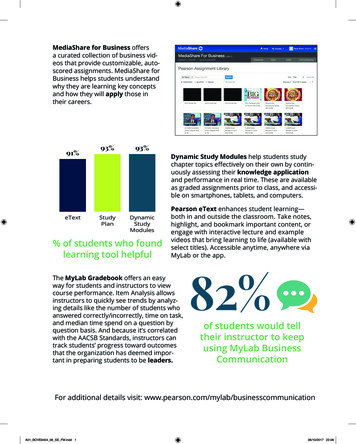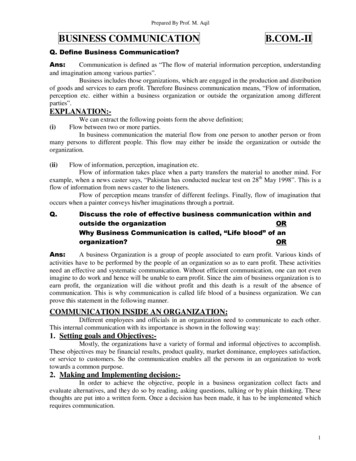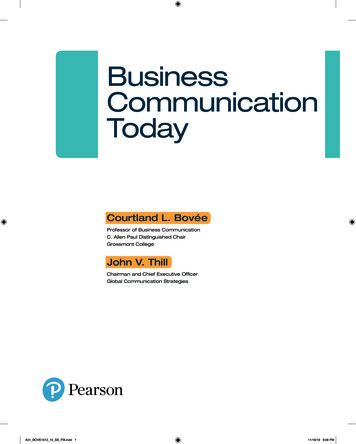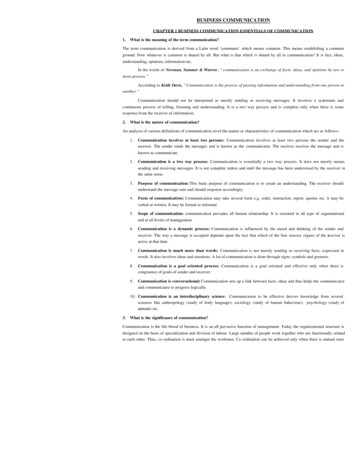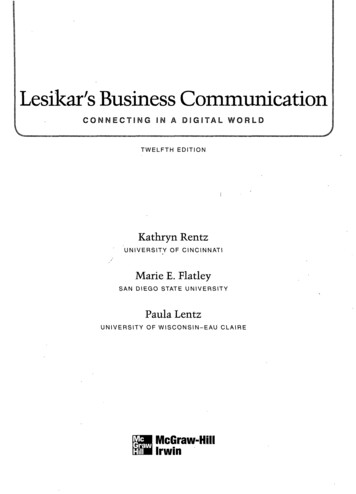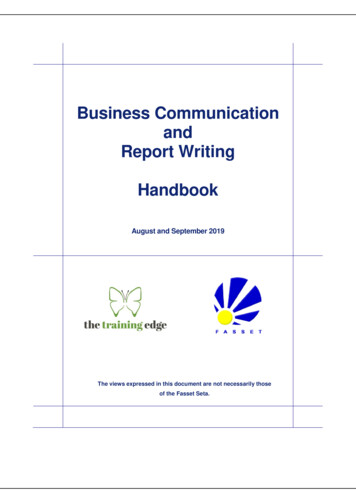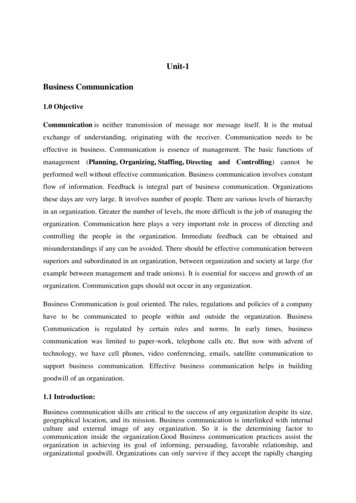
Transcription
Unit-1Business Communication1.0 ObjectiveCommunication is neither transmission of message nor message itself. It is the mutualexchange of understanding, originating with the receiver. Communication needs to beeffective in business. Communication is essence of management. The basic functions ofmanagement (Planning, Organizing, Staffing, Directing and Controlling) cannot beperformed well without effective communication. Business communication involves constantflow of information. Feedback is integral part of business communication. Organizationsthese days are very large. It involves number of people. There are various levels of hierarchyin an organization. Greater the number of levels, the more difficult is the job of managing theorganization. Communication here plays a very important role in process of directing andcontrolling the people in the organization. Immediate feedback can be obtained andmisunderstandings if any can be avoided. There should be effective communication betweensuperiors and subordinated in an organization, between organization and society at large (forexample between management and trade unions). It is essential for success and growth of anorganization. Communication gaps should not occur in any organization.Business Communication is goal oriented. The rules, regulations and policies of a companyhave to be communicated to people within and outside the organization. BusinessCommunication is regulated by certain rules and norms. In early times, businesscommunication was limited to paper-work, telephone calls etc. But now with advent oftechnology, we have cell phones, video conferencing, emails, satellite communication tosupport business communication. Effective business communication helps in buildinggoodwill of an organization.1.1 Introduction:Business communication skills are critical to the success of any organization despite its size,geographical location, and its mission. Business communication is interlinked with internalculture and external image of any organization. So it is the determining factor tocommunication inside the organization.Good Business communication practices assist theorganization in achieving its goal of informing, persuading, favorable relationship, andorganizational goodwill. Organizations can only survive if they accept the rapidly changing
global challenges and the communication processes are structured and delivered.The presentworkforce is dynamic in nature so communication is a challenge when executed against thebackdrop of culture, technology and competition. The success of any business to a largeextent depends on efficient and effective communication. Ittakes place among businessentities, in market and market places, within organizations and betweenvarious groups ofemployees, owners and employees, buyers and sellers, service providers andcustomers, salespersons and prospects and also between people within the organization and the press persons.All such communication impacts business. Done with care, such communication can promotebusiness interests. Otherwise, it will portray the organization in poor light and may adverselyaffect the business interest. Communication is the life blood of any organization and its mainpurpose is to effect change toinfluence action. In any organization the main problem is of maintaining effectivecommunication process. The management problem generally results in poor communication.Serious mistakes are made because orders are misunderstood. The basic problem incommunication is that the meaning which is actually understood may not be what the otherintended to send. It must be realised that the speaker and the listener are two separateindividuals having their own limitations and number of things may happen to distort themessage that pass between them. When people within the organization communicate witheach other, it is internal communication. They do so to work as a team and realise thecommon goals. It could be official or unofficial. Modes of internal communication includeface-to-face and written communication. Memos, reports, office order, circular, fax, videoconferencing, meeting etc. are the examples of internal communication. When people in theorganization communicate with anyone outside the organization it is called externalcommunication. These people may be clients or customers, dealers or distributors, media,government, general public etc. are the examples of external communication.1.2 Meaning of communicationThe word communication has been derived from the Latin word 'communicare' that means ‘toshare’.Communication may be defined as interchange of thought or information between twoor more persons to bring about mutual understanding and desired action. It is the informationexchange by words or symbols. It is the exchange of facts, ideas and viewpoints which bringabout commonness of interest, purpose and efforts. According to Keith Davis,‘The process ofpassing the information and understanding from one person to another."Communication issomething so simple and difficult that we can never put it in simple words," says T.S.Mathews. But we do need a definition to understand the term. In his book Communication inBusiness, Peter Littledefines communication as follows: “Communication is the process bywhich information is transmitted between individuals and / or organizations so that anunderstanding response results.” Another very simple definition of 'communication' has beenprovided by W.H. Newman and C.F. Summer Jr: “Communication is an exchange of facts,ideas, opinions, or emotions by two or more persons.”It is essentially a bridge of meaning between the people. By using the bridge a person cansafely across the river of misunderstanding’.It is the ability of mankind to communicate across barriers and beyond boundaries that hasusheredthe progress of mankind. It is the ability of fostering speedy and effectivecommunication around theworld that has shrunk the world and made ‘globalization’ a reality.Communication had a vital role toplay in ensuring that people belonging to a particularcountry or a culture or linguistic group interactwith and relate to people belonging to other
countries or culture or linguistic group. Communicationadds meaning to human life. It helpsto build relationship and fosters love and understanding. Itenriches our knowledge of theuniverse and makes living worthwhile.However, communication incorporates, besides commonality, the concepts of transfer,meaning and information. It implies that there must be a receiver if communication is tooccur. The sender of message must consider the receiver while structuring his message froma technical standpoint as well as in delivering it. When the receiver is not considered, there iseither no response or there is wrong response. Sharing of understanding would be possibleonly when the person, to whom the message is meant, understands it in the same sense inwhich the sender of the message wants him to understand. Thus, communication involvessomething more than mere transmission of the message or transmission and physical receiptthereof. The correct interpretation of the message is important from the point of view oforganizational efficiency. As such, the greater the degree of understanding presents in thecommunication, the more the likelihood that human action will proceed in the direction ofaccomplishment of goals.1.3 Importance and purpose of communicationJust as communication is vital for our existence in civilizes society, so also it is essential forfunctioning of organization. So without communication there would be noorganization.Needless to say, communication is the ingredient that makes organizationpossible. It is the vehicle through which the basic management functions are carried out.Managers direct through communication; they coordinate through communication; and theystaff, plan, and control through communication. Virtually all actions taken in an organizationare preceded by communication.Purpose Of CommunicationFor instruction: The instructive function unvarying and importantly deals with thecommanding nature. It is more or less of directive nature. Under this, the communicatortransmits with necessary directives and guidance to the next level, so as to enable them toaccomplish his particular tasks. In this, instructions basically flow from top to the lowerlevel.For integration: It is consolidated function under which integration of activities isendeavoured. The integration function of communication mainly involves to bring aboutinter-relationship among the various functions of the business organization. It helps in theunification of different management functions.For information: The purposes or function of communication in an organization is toinform the individual or group about the particular task or company policies andproceduresetc. Top management informs policies to the lower level through the middle level.In turn,the lower level informs the top level the reaction through the middle level.Information canflow vertically, horizontally and diagonally across the organization.Becoming informed orinform others is the main purpose of communication.For evaluation: Examination of activities to form an idea or judgement of the worth oftask is achieved through communication. Communication is a tool to appraise theindividualor team, their contribution to the organization. Evaluating one’s own inputs orother’soutputs or some ideological scheme demands an adequate and effectivecommunicationprocess.
For direction: Communication is necessary to issue directions by the top managementormanager to the lower level. Employee can perform better when he is directed by hissenior.Directing others may be communicated either orally or in writing. An order maybecommon order, request order or implied order.For teaching: The importance of personal safety on the job has been greatly recognized.Acomplete communication process is required to teach and educate workers aboutpersonalsafety on the jobs. This communication helps the workers to avert accidents, risk etc.andavoid cost, procedures etc.For influencing: A complete communication process is necessary in influencing othersorbeing influenced. The individual having potential to influence others can easilypersuadeothers. It implies the provision of feedback which tells the effect of communication.For image building: A business enterprise cannot isolate from the rest of the society. Thereisinterrelationship and interdependence between the society and an enterprise operating inthesociety. Goodwill and confidence are necessarily created among the public. It can bedone bythe communication with the different media, which has to project the image of thefirm in thesociety. Through an effective external communication system, an enterprise hasto inform thesociety about its goals, activities, progress and social responsibility.For employees orientation: When a new employee enter into the organization at thattime he or she will be unknown to the organization programs, policies, culture etc.Communication helps to make people acquainted with the co-employees, superior andwiththe policies, objectives, rules and regulations of the organization.1.4 Dimensions of CommunicationIn an organization, communication flows in 5 main directions1.2.3.4.5.DownwardUpwardHorizontal /LateralDiagonalGrapevine Communication1.4.1Downward Communication:Communication that flows from a higher level in anorganization to a lower level is a downward communication. In other words,communication from superiors to subordinates in a chain of command is adownward communication. This communication flow is used by the managers totransmit work-related information to the employees at lower levels. Employeesrequire this information for performing their jobs and for meeting the expectationsof their managers. Downward communication is used by the managers for thefollowing purposes – Providing feedback on employees’ performance. Giving job instructions. Providing a complete understanding of the employees’ job as well as tocommunicate them how their job is related to other jobs in the organization.
Communicating the organizations mission and vision to the employees. Highlighting the areas of attention.Organizational publications, circulars, letter to employees, group meetings etc are allexamples of downward communication. In order to have effective and error-free downwardcommunication, managers must: Specify communication objective. Ensure that the message is accurate, specific and unambiguous. Utilize the best communication technique to convey the message to the receiver inright formUpward Flow of Communication: Communication that flows to a higher level in anorganization is called upward communication. It provides feedback on how well theorganization is functioning. The subordinates use upward communication to convey theirproblems and performances to their superiors.The subordinates also use upward communication to tell how well they haveunderstood the downward communication. It can also be used by the employees toshare their views and ideas and to participate in the decision-making process.Upwardcommunication leads to a more committed and loyal workforce in an organizationbecause the employees are given a chance to raise and speak dissatisfaction issues tothe higher levels. The managers get to know about the employees’ feelings towardstheir jobs, peers, supervisor and organization in general. Managers can thusaccordingly take actions for improving things.Grievance Redressal System, Complaint and Suggestion Box, Job Satisfactionsurveys etc all help in improving upward communication. Other examples of UpwardCommunication are -performance reports made by low level management forreviewing by higher level management, employee attitude surveys, letters fromemployees, employee-manager discussions etc.1.4.2Lateral / Horizontal Communication: Communication that takes place at samelevels of hierarchy in an organization is called lateral communication, i.e.,communication between peers, between managers at same levels or between any
horizontally equivalent organizational member. The advantages of horizontalcommunication are as follows: It is time saving. It facilitates co-ordination of the task. It facilitates co-operation among team members. It provides emotional and social assistance to the organizational members. It helps in solving various organizational problems. It is a means of information sharing. It can also be used for resolving conflicts of a department with other departmentor conflicts within a department.1.4.3Diagonal Communication or crosswise communication: Communication thattakes place between a manager and employees of other workgroups is calleddiagonal communication. It generally does not appear on organizational chart. Forinstance - To design a training module a training manager interacts with anOperations personnel to enquire about the way they perform their task. TheAccounts people of an organization visiting different employees in variousdepartments for their IT calculation, bonus for workers etc. fall under diagonalcommunication.1.5 Channels of communicationA breakdown in the communication channel leads to an inefficient flow of information.Employees are unaware of what the company expects of them. They are uninformed of whatis going on in the company.This will cause them to become suspicious of motives and any changes in the company. Alsowithout effective communication, employees become department minded rather thancompany minded, and this affects their decision making and productivity in the workplace.Eventually, this harms the overall organizational objectives as well. Hence, in order for anorganization to be run effectively, a good manager should be able to communicate to his/her
employees what is expected of them, make sure they are fully aware of company policies andany upcoming changes.Therefore, an effective communication channel should be implemented by managers tooptimize worker productivity to ensure the smooth running of the organization.1.5.1 Formal Channels of CommunicationThe messages which are circulating on regulated, preset channels, of an organization arecreating the formal communication. The content of the communication is related to theorganization’s activity, to the work and to anything which is related to those. The formalcommunication can consist in verbal messages, nonverbal messages, written, under the shapeof letters, telephone messages, radio messages, printed, internal notes. Even some gesturescan consist in formal communication. The messages are transmitted by the authorized ones:on official channels, these arrive to the ones who need to react, to people or machines whichneed to know the content of these messages.Usually, all formal communications are recorded and kept in the organization’s evidence. Areretained copies of these by the transmitter, by the receiver, by all of the desks from theorganization which need to know and keep the information. Examples of formalcommunications are given by work commands, reports and financial evidence, reports oversells / inventory, statements referring to the company’s policies, post descriptions, etc.The formal communication network is formed out of formal channels, created by setting aformal system of responsibilities according to the hierarchical structure of the organization.The perfect network is the one which contains communication channel from bottom up,downwards and horizontally. Often the direction of horizontal communication is missing or itis inefficient and in this way the accuracy of the information decreases. The situation isappearing because of the lack of permanent circulation of the information betweendepartments, although this is vital for the organization in conditions of existent competition,or the lack of specialists in organizational communication.The number of communication channels available to a manager has increased over the last 20odd years. Video conferencing, mobile technology, electronic bulletin boards and faxmachines are some of the new possibilities.As organizations grow in size, managers cannotrely on face-to-face communication alone to get their message across. A challenge themanagers face today is to determine what type of communication channel should they opt forin order to carryout effective communication.In order to make a manager's task easier, the types of communication channels are groupedinto three main groups: formal, informal and unofficial. A formal communication channel transmits information such as the goals, policiesand procedures of an organization. Messages in this type of communication channelfollow a chain of command. This means information flows from a manager to hissubordinates and they in turn pass on the information to the next level of staff.An example of a formal communication channel is a company's newsletter, whichgives employees as well as the clients a clear idea of a company's goals and vision. Italso includes the transfer of information with regard to memoranda, reports,directions, and scheduled meetings in the chain of command.
A business plan, customer satisfaction survey, annual reports, employer's manual,review meetings are all formal communication channels.1.5.2 Informal Channels of CommunicationInformal communication arises out of all those channels that fall outside the formal channelsand it is also known as grapevine. It is established around the societal affiliation of membersof the organization. Informal communication does not follow authority lines as in the case offormal communication.Informal communication takes place due to the individual needs of the members of anorganization and subsists in every organization. Normally, such communication is oral andmay be expressed even by simple glance, sign or silence. Informal communication, isimplicit, spontaneous multidimensional and diverse. It often works in group of people, i.e.when one person has some information of interest; he passes it on to his informal group andso on.An organization can make efficient use of informal channels to fortify the formal channels ofcommunication. It acts as a valuable purpose in expressing certain information that cannot bechanneled via the official channels. It satisfies the people desires to identify what ishappening in the organization and offers an opportunity to express dreads, worries andcomplaints. Informal communication also facilitates to ameliorate managerial decisions asmore people are involved in the process of decision-making.Inspite on many advantages, informal communication has certain disadvantages. Informalcommunication contains facts, deceptions, rumors and unclear data. The informal channels ofcommunication may transmit completely imprecise information that may harm rather thanhelp an organization. In addition, it is impossible to fix the responsibility for its origin or flowof information. However, for the efficient working of any organization both formal andinformal communications are required.An example of an informal communication channel is lunchtime at the organization'scafeteria/canteen. Here, in a relaxed atmosphere, discussions among employees areencouraged. Also managers walking around, adopting a hands-on approach to handlingemployee queries is an example of an informal communication channel. Quality circles, teamwork, different training programs are outside of the chain of command and so, fall under thecategory of informal communication channels.1.5.3 Grapevine Communication (Informal Communication)Grapevine is an informal channel of business communication. It is called so because itstretches throughout the organization in all directions irrespective of the authority levels. Manas we know is a social animal. Despite existence of formal channels in an organization, theinformal channels tend to develop when he interacts with other people in organization. Itexists more at lower levels of organization. Grapevine generally develops due to variousreasons. One of them is that when an organization is facing recession, the employees senseuncertainty. Also, at times employees do not have self-confidence due to which they formunions. Sometimes the managers show preferential treatment and favour some employeesgiving a segregated feeling to other employees. Thus, when employees sense a need toexchange their views ,they go for grapevine network as they cannot use the formal channel of
communication in that case. Generally during breaks in cafeteria, the subordinates talk abouttheir superior’s attitude and behaviour and exchange views with their peers. They discussrumours about promotion and transfer of other employees. Thus, grapevine spreads like fireand it is not easy to trace the cause of such communication at times.Example of Grapevine Network of Communication1. Suppose the profit amount of a company is known. Rumour is spread that this muchprofit is there and on that basis bonus is declared.2. CEO may be in relation to the Production Manager. They may have friendly relationswith each other.Advantages of Grapevine Communication1. Grapevine channels carry information rapidly. As soon as an employee gets to knowsome confidential information, he becomes inquisitive and passes the details then tohis closest friend who in turn passes it to other. Thus, it spreads hastily.2. The managers get to know the reactions of their subordinates on their policies. Thus,the feedback obtained is quick compared to formal channel of communication.3. The grapevine creates a sense of unity among the employees who share and discusstheir views with each other. Thus, grapevine helps in developing group cohesiveness.4. The grapevine serves as an emotional supportive value.5. The grapevine is a supplement in those cases where formal communication does notwork.Disadvantages of Grapevine Communication1. The grapevine carries partial information at times as it is more based on rumours.Thus, it does not clearly depicts the complete state of affairs.2. The grapevine is not trustworthy always as it does not follows official path ofcommunication and is spread more by gossips and unconfirmed report.3. The productivity of employees may be hampered as they spend more time talkingrather than working.4. The grapevine leads to making hostility against the executives.5. The grapevine may hamper the goodwill of the organization as it may carry falsenegative information about the high level people of the organization.A smart manager should take care of all the disadvantages of the grapevine and try tominimize them. At the same time, he should make best possible use of advantages ofgrapevine.1.6 Functions of communicationThe most basic functions of communication in an organization are to inform, control,motivate and emotional expression.1.6.1. InformationAn organization needs a vast amount of information to function and operate a business. Thetop management would require timely and accurate information for the various departmentsto make effective decisions. Information is dispersed throughout an organization through
written or verbal communication. A human resources representative or business owner maysend out a memo explaining a change in the company's health plan. A business meeting maybe used as a way to communicate a new office procedure. A webinar allows a company toconduct a meeting over the Internet with employees or customers who cannot attend inperson. The idea of informing within an organization is to provide data and information sothat employees can effectively complete their job. Information ensures that an employee isaware of the rules and procedures of an organization. It also eliminates job uncertainty forworkers when they are fully informed.1.6.2 ControlThe management of any organization will always have plans with long, medium or longtermobjectives for the months and years ahead. To achieve these objectives, the daily &monthly activities must proceed as planned in order to achieve the objectives for theperiod.Communication acts to control member behavior in several ways. Organizations haveauthority hierarchies and formal guidelines that employees are required to follow. Whenemployees, for instance for instances are required to first communicate any job relatedgrievance to their immediate boss, to follow their job description, or to comply with companypolicies, communication is performing a control function. But informal communication alsocontrols behavior. When work groups tease or harass a member who produces too much (andmakes the rest of the group look bad) they are informally communicating with, andcontrolling the member’s behavior. A company uses communication as a way to maintaincontrol over employees and their work environment. Written human resources policies andprocedures dictate how employees are permitted to act in the workplace. Job descriptionsoutline the parameters of an employee's job functions. Performance reviews control whetheran employee receives a raise or attains a promotion.1.6.3 MotivationManagers use communication to motivate workers to achieve peak performance. Byclarifying the expectations of employees and providing incentives for meeting or exceedingexpectations, communication can help companies reach specific objectives. For example, bycommunicating to salespeople that they'll receive a 10 percent bonus if they reach theirannual sales goal, it helps the company reach its overall sales goals. Communication fostersmotivation by clarifying to employees what is to be done, how well they are doing and whatcan be done to improve performance if it’s subpar. We saw his operating in our review ofgoal-setting and reinforcement theories. The formation of specific goals, feedback onprogress toward the goals, and reinforcement of desired behavior all stimulate motivation andrequire communication.1.6.4. Emotional Expression and InterdependenceEmotional appeal is when emotions or arguments are used to persuade others instead offacts or logic. Organizations can use emotional appeals when delivering bad news. Last year,the CEO spoke to the entire company at an emergency meeting. He explained how devastatedhe was over the need to have a corporate downsizing. He used emotion to explain that it wasbetter for the overall security of the company to eliminate some positions. For manyemployees, their work group is a primary source for social interaction. The communicationthat takes place within the group is a fundamental mechanism by which members show their
frustration and feelings of satisfaction. Communication therefore provides release for theemotional expression of feelings and for fulfillment of social needs.1.7 Technology and Business CommunicationTechnology has changed business in many ways, but its effect on communication is arguablythe most significant. The use of technology in daily business operations is constantlyevolving, and one such example is the use of technology in business communication. Beingin touch is very important to businesses, that is why it is no wonder why a lot of resources isspent in improving the communication procedures of various businesses. The revolution ofthe Internet has allowed businesses to have more options as far as business communicationwas concerned. It made the technologies of software, hardware, and network converge intoone cohesive and solid system, which made the optimization of various business proceduresfaster. Indeed, the employees and the organizations as a whole greatly benefit from the use oftechnology in business. With a feasible business plan, organizations can save a lot of moneyand raise the level of productivity of the staff if the use of technology were well-planned andexecuted. Even medium-scale companies now have a chance to participate in the fiercecompetition among larger businesses. This is just one proof that technology in businesscommuni
Unit-1 Business Communication 1.0 Objective Communication is neither transmission of message nor message itself. It is the mutual exchange of understanding, originating with






